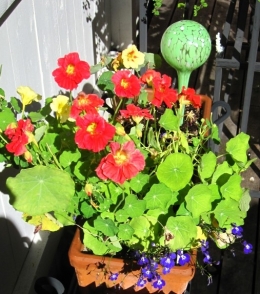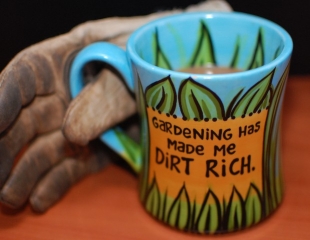Posts Tagged ‘joy’
Herbs – the spice of life
When late afternoon arrives in our patch of yard, we turn on the reading lights. That’s because we live in dappled shade and shadows from our forested northeastern exposure. 1/2 block away it’s full sun, while we’re calling it a day.
One outcome of our scant daylight is we don’t grow food, or anything else that requires full sun. Which is OK by me because my short stint as a food grower was neither a personal or agricultural success.
Consumers are people, too
I support the concept of growing your own nutrition, but I do not support the worry: fungus, beetles, blight, cut worms, watering, fertilizing, weeding, thinning, fencing and harvesting gallons of one thing (I hope you like squash, dear). And then, it starts again next year. From scratch.
Do I lack intestinal fortitude? No, I just can’t tolerate the suspense of bringing in a crop. I gladly shop for local produce. Just leave me to my perennials.
Best of both worlds
I designed my garden for other senses – mind, eye, nose
– outdoor spaces, fragrant offerings, inspiring creations, intriguing curves, mini-vistas and low maintenance. OK, I pamper the roses a bit. Everything else weathers; a planting survives and thrives or … succumbs. Perennial pragmatism.My one exception: herbs and annuals in pots. I hate buying fresh mint at the supermarket. Ditto parsley, sage rosemary and thyme, invariably expensive or trucked from Mexico. In pots, these herbs unfailingly just grow, and without fuss — my kind of crop! They satisfy my gardening principles while providing a culinary and aesthetic je ne sais quoi.
Besides the flavor-your-food value of herbs, groupings of pots in different shapes and sizes partition and highlight an area, add graceful greenery / vivid accents, and blend practical herbs with vibrant annuals (my fave – nasturtium with lobelia). Pots of varying sizes, habitats and materials punctuate my external rooms.
I have a few herbal and non-herbal relics that winter over — bits of this and that: liatris spicata, lamium “White Nancy”, dicentra, ferns. Even my potted oregano returns each year and mint, running freely in the perennial beds, is rampant. While they do not survive Zone 6A winter, I’ve harvested parsley in late December and rosemary in January. First frost does in the basil – it’s known as a tender perennial.
Terracotta and Not
I use both clay pots and plastic pots. Classic terracotta (literally baked earth, unglazed clay) is porous, warm and weathered. Saucers under the clay pots extend the watering effect. Plastic scores lower for aesthetics but meets the low maintenance requirement because it conserves moisture much better than terracotta. That means less stress on the plants and less work for me.
I’ve taken to the heavily glazed, gigantic earthenware pots from Vietnam. They conserve water, do not crack like terracotta and make a bold statement that anchors a grouping of smaller pots. Filled with soil, they stay put!
Global watering
For pots that need chronic watering, I discovered a remedy that works pretty well — the glass watering globes that you fill with water and stick into the potted soil.
In the past I had tried mixing in the gelatinous granules (polymers) that soak up water and then release it to the plants. It’s a clever idea that doesn’t work well. Mostly the granules expand beyond reason, force the soil out of the pot, and don’t deliver much water to the roots of your potted plants. My experience is supported by research.Food for Thought
While my aesthetic vision continues to conjure up garden designs, I find joy in snipping fresh rosemary, basil, and perennial mint into my cuisine, or pinching a spicy nasturtium flower to decorate dinner. It’s another way I delight my soul.
Dirt – A Love Story
It’s everywhere! We scrub it off our hands, our shoes, our personae. We think: clean = good, dirt = bad. Even gardeners succumb to dirt-riddance — we clean our gardens in the spring! But I’m telling you — dirt is your friend, not your enemy.
Here’s why.Get Smart – Eat Dirt!
Dirt harbors essential micro-organisms (like bacteria and fungi). “Yikes!“, you shriek, “That’s a good thing?“. Not just good, essential.
Soil scientists say each gram of soil (less than a teaspoonful) contains over 1,000,000,000 microbes (1 billion!), hosting over 10,000 different species. Here’s what some of these buggers do:
- grow our crops,
- convert wastes into compost,
- deliver vitamins to plants (in the “rhizosphere“),
- kill insects,
- consume toxic waste (like oil spills), and
- create soil in the first place
When soil is first made, for example after a volcano, some nutrients are missing, including nitrogen and carbon. Therefore, the first organisms to colonize the soil are generally nitrogen fixers and photosynthesizers that fix carbon. [DLC-ME]
Furthermore, a study conducted by researchers Dorothy Matthews and Susan Jenks at The Sage Colleges (Troy, NY) suggests that soil-borne germs play a role in reducing anxiety and enhancing learning. The study attracted lots of coverage, like “Can Bacteria Make You Smarter?” (Science Daily) and on Radio Netherlands “The Dirt Show“. Here the two researchers pose with dirt martinis (yuk!).
Anyway, get smart — eat dirt!
Dirt – Accidentally in Love
I began my wholesome relationship with dirt by accident, often the case with true love. I had planned a border along the front driveway and set to work removing a strip of sod about 2 feet wide and 80 feet long. I had loam delivered to create the bed where the sod once was. For expediency, I dumped the torn up sod in a low spot in the backyard; it formed a chunky mound on which I later dumped fall leaves and some additional loam on top to hold it all in place.
I finished the driveway border project, planting daylilies, astilbe and daffodils topped with a layer of bark mulch. Over the next couple of years I expanded the experimental mound in the backyard, adding a curved path with pea stone gravel, throwing in Bleeding Hearts, Oriental lilies, astilbe, a leftover Alberta Spruce, a red twig dogwood, Japanese dwarf spirea, ferns (etc.). What I found was — it didn’t matter what I planted there. Everything flourished. I had accidentally created a rich, organic home for my woodland plants! Dirt won me over and I’m accidentally in love!
I’ve since enlarged the accidental garden with yard clippings, chopped oak leaves, more loam, and barn “soil” from a nearby stable. In the expanded section, I added shrub roses, Columbine, an ornamental Japanese maple, American ginger, epimedium, sweet pepperbush (Clethra) and a stone wall. We’re happy together.
The Joy of Dirt
Back to the driveway border. It perennially struggles — its loamy bed dries out in summer because it doesn’t have enough organic material to store water for long. The day lilies come up OK, but they haven’t prospered; ditto the daffodils. Some day, I will re-visit this project and give it the tender lovin’ dirt it needs.
I’ve started another mound in the front yard: lawn clippings, chopped leaves, compost from the Marshfield transfer station (aka, the dump), and a decorative covering of bark mulch. It’s January and the mound is slumbering beneath a foot of snow, while microorganisms and worms are busily feeding and creating new dirt. Oh, joy!
Now it’s your turn — Share the dirt!

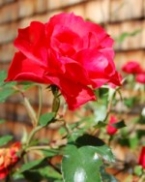
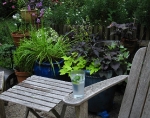 pots-with-chair
pots-with-chair potted-herbs-annuals
potted-herbs-annuals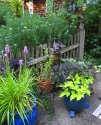 pots-with-chair2
pots-with-chair2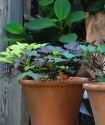 pots-sweetpotato
pots-sweetpotato